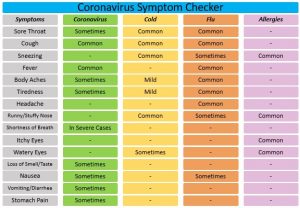Article updated with latest information on 07/09/2020.
One of the challenging aspects of COVID-19 is that some of the symptoms associated with it are similar to that of the common cold, allergies or the flu. The other issue is that the virus is still so new that all possible symptoms are known yet. This can make it challenging to know if you have the virus or not.
Symptoms associated with the common cold are sore throat, cough, sneezing, runny/stuffy nose, mild body aches, mild tiredness, and sometimes watery eyes. For allergies, symptoms usually include sneezing, runny/stuffy nose, itchy eyes, and watery eyes. Symptoms of the flu are sore throat, cough, fever, body aches, tiredness, and headache. Some individuals with the flu also have sneezing, runny/stuffy nose, and nausea.
The symptoms for COVID-19 are definitely cough and fever with some people also experiencing a sore throat, runny nose, nasal congestion, body aches, chills, repeated shaking with chills, headache, tiredness, nausea, vomiting, diarrhea, stomach pain, and loss of sense of smell and/or taste. The digestive tract upset and changes in sense of smell/taste have only recently been added to the list of possible symptoms. In severe cases, many individuals are having shortness of breath, which is the reason why many people need to hospitalized.
As you can see it’s hard to differentiate between the various illnesses. To make it easier, we created a side by side comparison. Please download and/or print our COVID-19 Symptom Checker to use at your convenience. By knowing what symptoms to look for, you’ll know when to seek help. It’s important to remember that any time you feel like you can’t catch your breath, you can’t take a deep breath or you’re having trouble breathing, seek medical help immediately.